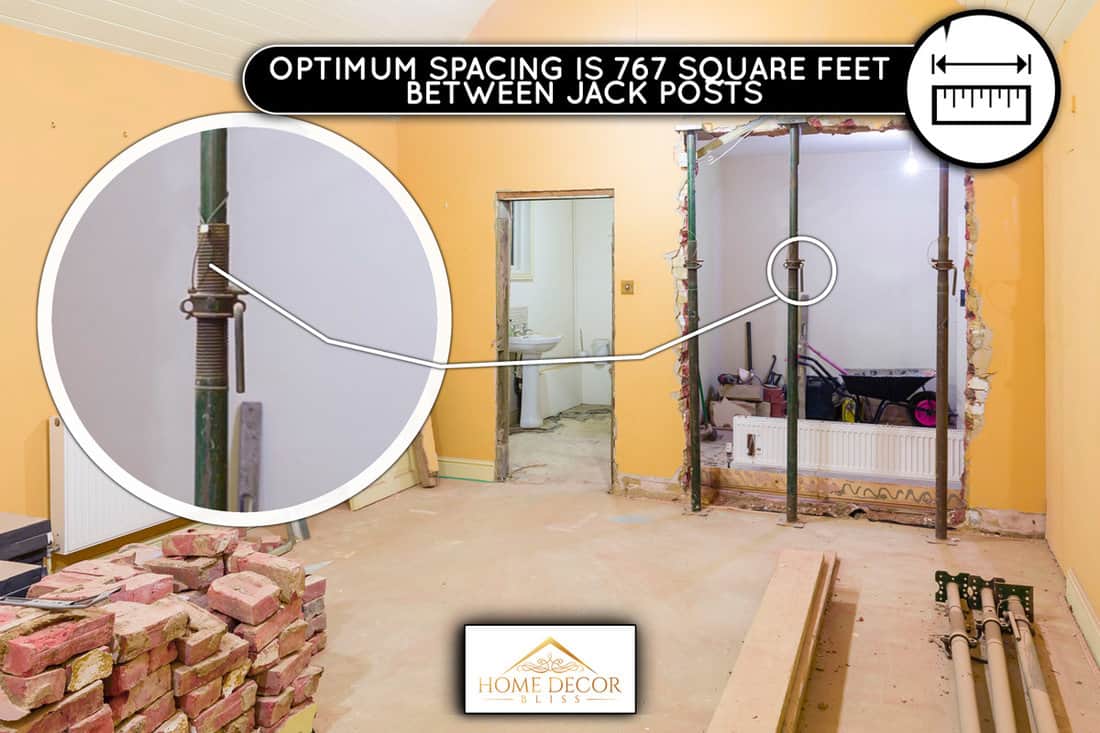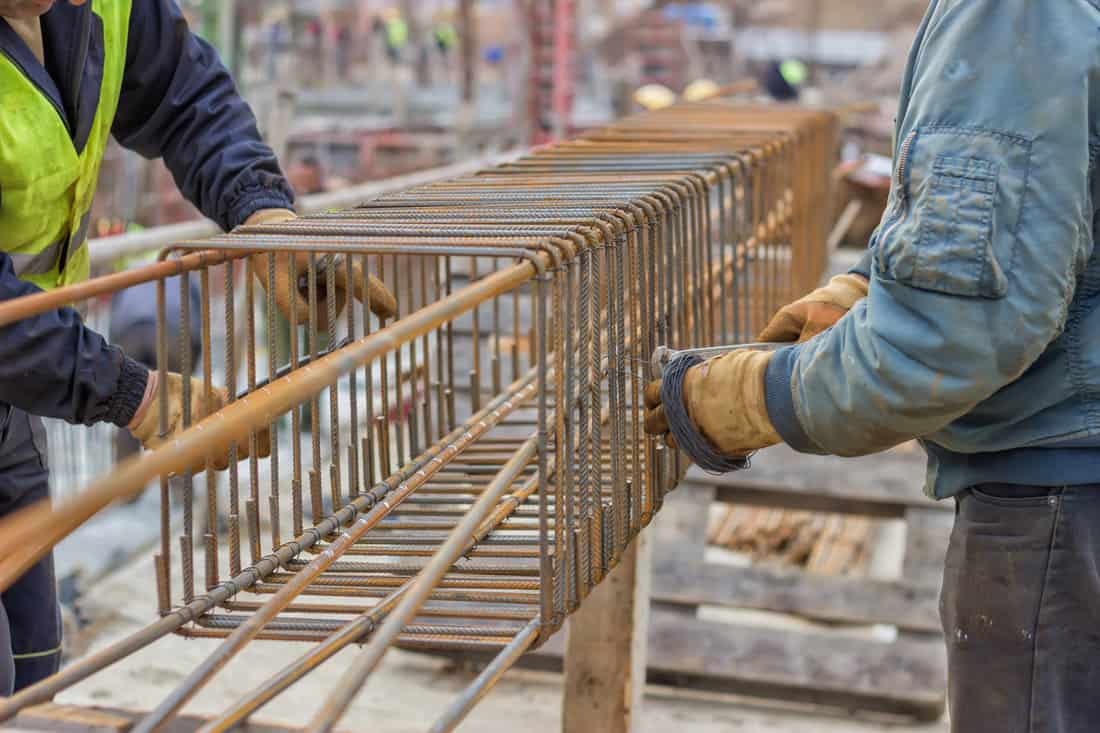Have you ever wondered how far apart basement jack posts should be? Is there a standard distance between them? If so, you may be wondering what's the best way to determine this. Our research has provided us with a great answer to this question.
There is no hard and fast rule for the number of jack posts and spacing you should have. However, we found out that the optimal spacing is 767 square feet between jack posts. This should enable the jack posts to spread the load across a wider area of the floor.
There is a lot of debate over whether jack posts should be spaced apart at certain distances. However, too many variable factors are involved, so a universal rule for spacing is impossible. Nonetheless, we'll show you a formula that you can use to calculate and determine the best spacing for your situation. Read on, so you don't miss anything!

What Are Jack Posts?
As your home’s foundation settles, your floors may begin to sag. If this happens, your home is likely experiencing uneven loading on the supporting joists.
Jack posts are installed to prevent the floors from sagging. These are designed to provide support for the floor above. Jack posts prevent your floors from sinking in the affected areas and allow them to remain stable and flat.
Calculating optimum spacing between jack posts
A jack post has a maximum load capacity of 38,000 lbs. Meanwhile, a standard American floor is required by the local building code to hold up to 40 lbs per square foot. If the size of a standard American home is 2,301 square feet, that means it should have a floor load capacity of 92,040 lbs.
Divide the total floor load capacity of a standard American home by the maximum load capacity of a jack post, and you'll get 2.5. So you'll be needing 3 jack posts for a standard-size American home because you can't buy half of a jack post.
Divide the standard size of an American home by 3, which should give us the result of 767 square feet of distance between each jack post.
Here's a quick video explaining what a jack post is:
How To Install Jack Posts
Installing jack posts is not as overwhelming as you might think. You can install these yourself if you have time to dedicate to this project.
There are a few things you will need to take into account before beginning the installation process. First, determine where the floor is going to sag. This should be determined by measuring the length of the floor and the amount of load being applied, and the frequency. These two factors contribute to the eventual sagging and bowing of floors.
This is quite an advanced level of problem-solving, as you are anticipating a problem that is not yet there. You may think of this as a preventive measure for your home.
Next, decide what the problem area is. This can be determined by looking at the floorboards and determining which ones show signs of sagging.
Here are the steps to follow for installing jack posts:
1. Read the instructions first
The manufacturer's instructions will usually include detailed information on how to install the jack post. Check if you're missing any bolts, screws, and other accessories.
2. Position the jack post vertically below where the floor is sagging.
The steel plate is the part of the jack post that sits on top of the joist and provides the actual support for the weight of the structure. It should be flat on all sides to provide a stable base for the jack post to sit on.
When installing jack posts, you must consider the angle of the load. Jack posts are usually installed vertically, so a spirit level is your best friend to ensure that the jack post is perpendicular to the joists. A slight angle deviation can make a big difference in load distribution.
3. Position the steel plates
The jack post is set in place, and the load is transferred. The jack post is set in place by measuring the distance from the center of the steel plate to the joist and then marking that distance on the steel plate. You can choose a jack post that is as long as or shorter than your flooring, depending on the amount of sag you're trying to correct.
Jack posts are designed to be fully adjustable, which means they can be repositioned and tightened to meet your flooring needs.
The jack post must be set to the proper height. To ensure this, determine the actual distance between the joist and the basement floor by using a measuring tape to measure the span. The jack post must be set at the correct height to flush against the joist and the basement floor.
Once the jack post is positioned, it should be fitted firmly against the steel plate. The more snug is jack post is to the steel plate, the more secure it is.
4. Slowly crank the jack post
Put the bolts, nuts, and screws in place and start cranking the jack post until it's fully secured and tight between the joist and basement floor. When you are finished, make sure to check the sag again.
If it is too much, stop cranking and inspect the floor joist for signs of stress. Adjust accordingly. You'll know if the sag is leveled out and the load distribution is even when the floor does not creak whenever someone walks on it.
Here's a quick video on how to install a jack post:
By How Much Should You Raise A Sagging Floor With A Jack Post?
If you have a sagging floor, you may have heard of the term "jacking up," which refers to the act of lifting your floor to make it level. However, it is important to know that you should not jack your floor more than 1/8 of an inch at a time.
One of the best ways to prevent the floor from moving is to jack it up slowly rather than doing it all at once. It's best to take small, controlled steps rather than trying to do everything in one go. The reason you shouldn't jack your floor too quickly is that if you do, you may crack the wall.
Do You Need A Footing For Jack Post?
A footing is a type of foundation that is used to provide stability to the jack post and prevent it from moving.
To ensure structural integrity, jack posts should be installed with a footing. If the footing is not adequately reinforced, the jack post will tend to deflect and move out of its position.
Can A Jack Post Be Used As A Permanent Solution?
Jack posts are generally used for temporary support of building elements, such as walls, ceilings, and trenches. They are used because they are relatively inexpensive and easily installable. However, they are not recommended as a permanent solution.
You can use a jack post temporarily if you're waiting for the materials for a permanent fix, but remember that this support system will need to be removed once the structure is repaired.
Check out this jack post on Amazon
How Much Space Between Load Bearing Columns?
Load-bearing columns are columns that support the weight of the building. Load-bearing columns help stabilize a structure by providing a platform on which other parts of the building can be placed.
Most architectural guidelines recommend that the load-bearing columns should be spaced approximately 2.5 meters apart minimum and 7.5 meters maximum, respectively.

Can A Support Post Be Moved In The Basement?
In most homes, the floor joists are supported by support posts. They are usually made of metal and installed to extend down to the basement floor, where they are firmly attached.
If the support post's structural integrity is compromised (for whatever reason), it can cause the floor to begin to shift. This causes more damage to the house as it shifts, and it can even cause the entire structure to collapse.
If you notice any sign of shifting in your home, call a local structural engineer. The engineer can help you determine whether or not you should move the support post to prevent further damage.
How Much Will It Cost For Additional Support Posts In Basement?
Many variables go into the cost of installing a basement support post. This includes the size of the floor (where load capacity is calculated), the quality of the wood or type of steel used, and the depth of the basement wall. In addition, labor costs will affect the total project cost.
As a rule, contractors generally charge more for more complex jobs. For example, installing a support post that has multiple components will be more expensive than installing one that is built on a single slab of concrete. Nonetheless, you can expect an initial price quote of $1,200 to $5,000 for a newly-built basement. Replacement would cost you around $7,000 to $25,000.

How Strong Is A Concrete Column?

Concrete columns are commonly used to stabilize buildings that are being constructed in areas that are prone to earthquakes. To do this, concrete columns must sustain loads more than or equal to 1,700 PSI (pound per square inch). You'll see concrete columns that support many more pounds of weight than 1,700 PSI. These are called "ultra-high-performance concrete" or UHPC.
In the past, UHPC columns were used in buildings that were being built in areas where there was a higher chance of experiencing an earthquake.
But now, UHPC has become the standard for new building construction. You can't use concrete with less than 1,700 PSI for structural purposes.
In Closing
We've got a handy little equation that will give you a good estimate of how much space you should leave between your jack posts. Use this as a guideline, but not as a hard-and-fast rule.
You might also like:

